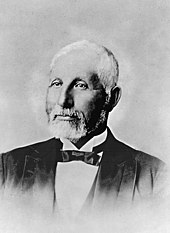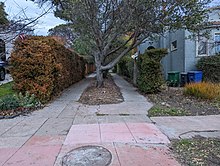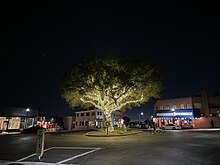Kensington, California
Kensington | |
|---|---|
 | |
 Location inContra Costa Countyand the state ofCalifornia | |
| Coordinates:37°54′38″N122°16′49″W/ 37.91056°N 122.28028°W[1] | |
| Country | |
| State | California |
| County | Contra Costa |
| Government | |
| •County Board | District 1: John Gioia |
| •State Senate | Nancy Skinner(D)[2] |
| •State Assembly | Buffy Wicks(D)[3] |
| •U. S. Congress | John Garamendi(D)[4] |
| Area | |
| • Total | 0.956 sq mi (2.48 km2) |
| • Land | 0.947 sq mi (2.45 km2) |
| • Water | 0.009 sq mi (0.02 km2) 0.97% |
| Elevation | 587 ft (179 m) |
| Population (2010) | |
| • Total | 5,077 |
| • Density | 5,300/sq mi (2,100/km2) |
| Time zone | UTC-8(PST) |
| • Summer (DST) | UTC-7(PDT) |
| ZIP codes | 94707, 94708 |
| Area code | 510, 341 |
| GNISID[1][6][7] | 1658891,2408472 |
| FIPScode[1][7] | 06-38086 |
Kensingtonis anunincorporated communityandcensus designated placelocated in theBerkeley Hills,in theEast Bay,part of theSan Francisco Bay Area,inContra Costa County, California.In the 20th century it was considered part of Berkeley, although it is across the county line. House numbers follow the pattern used in Berkeley, and Kensington shares two zip codes with the Berkeley Hills area.
The population was 5,077 at the 2010 census.[8][9]Kensington’s community is mostly highly educated and affluent, and it contains only single family residential houses. It is among the safest and cleanest places in the United States, with one of the nation’s top public elementary schools. Many distinguishedUniversity of California, Berkeleyprofessors, Nobel Prize laureates, and other notable San Francisco Bay Area professionals reside or have resided in Kensington, such asUniversity of California, Berkeley’stheoretical physicistand professor of physicsRobert Oppenheimerwho was the Director of theManhattan Project’s Project Ythat developed the atomic bombs during World War II.
Law and government
[edit]Kensington is anunincorporated communityofContra Costa Countythat bordersAlameda County.Unlike many unincorporated communities, Kensington has local jurisdiction over itspolice department,parkservices,refuse collectionandfire department.These are governed by two elected boards. The five-memberKensington Police Protection and Community Services District(KPPCSD) Board oversees the police department, park services, and refuse collection. The five-memberKensington Fire District Boardoversees the fire department and emergency medical services, of which the day-to-day function is outsourced to the fire department ofEl Cerrito,a neighboring city. The Kensington Municipal Advisory Board (KMAC) is a commission whose members are appointed by the Contra Costa County Board of Supervisors. KMAC is charged with land-use and development review and provides recommendations to the county planning and public works departments.
The sewer system is maintained by theStege Sanitary District,which also includes the city of El Cerrito and theRichmond Annexarea of Richmond. TheEast Bay Municipal Utility Districtsupplies water and wastewater treatment services.[10]AC Transitoperates local transit service.
History
[edit]
The area that is now Kensington was originally the territory of the Huchiun band of theOhloneIndigenous people who occupied much of the East Bay of the San Francisco Bay Area. ThePedro Fagesmapping expedition passed through the area in 1772.
In 1823, the Republic of Mexico grantedRancho San Pablo,an extent of land lying north of Cerrito Creek and theRancho San Antonio,including that portion of land that is now Kensington, to Francisco María Castro, a veteran of the Mexican Army and formeralcaldeof San José. In 1831 his youngest son,Victor Castro,inherited the southern portion of the rancho, including what is now Kensington.
In 1892, Anson Blake purchased a portion of Castro's land, most of which is now Kensington.
George Shimabought ten acres north of Cerrito Creek and east of the present day Arlington Avenue in about 1911, intending to build a home there. He hosted an annual community picnic on the property for some time.
Land development companies had bought most of the Kensington area by 1911, when it was first surveyed. The area was named "Kensington" that year by Robert Brousefield, a surveyor who had lived in theLondondistrict ofSouth Kensingtonin theRoyal Borough of Kensington and Chelseaat one time. The first subdivisions were Kensington Park and Berkeley Park west of Arlington Avenue, with most streets named for locations in England, and Berkeley Highlands, with most streets named for colleges and universities.
Farmers in Kensington resisted inclusion in the city of El Cerrito when it was incorporated in 1917, and local voters have rejected incorporation various times since then.
In the 1920s, theEast Bay Municipal Utility District(EBMUD) constructed an aqueduct through theBerkeley Hillsto transport water from theSan Pablo Reservoirto a still-active pumping facility in Kensington, located just above the Colusa Circle. Some of the water received by this facility is pumped up the hill to the Summit Reservoir located at the top of Spruce Street. The rest is pumped to other reservoirs serving the East Bay.
The population of Kensington was 226 in 1920, 1,423 in 1930, 3,355 in 1940, and reached a peak of 6,601 in 1950.
During World War II,J. Robert Oppenheimerlived at 10 Kenilworth Court where he held meetings of the American Communist Party, while simultaneously working on top secret atomic bomb work, and denying any involvement with such political groups. The house is often mistakenly described as being in Berkeley. Later in his life, Oppenheimer lived at 1 Eagle Hill, also in Kensington.[11]

Until 1948, streetcar line #7 of theKey Systemran to Kensington from Berkeley along Arlington Avenue, terminating in the small commercial area at Amherst Avenue. The streetcar was then replaced by anAC Transitbus route of the same number, which continues to run along Arlington Avenue. The streetcar service played an important role in the development of Kensington, and was fed by a network of mid-block pedestrian paths, most of which persist to this day. The pathways, which traverse Kensington, were offered for dedication for public use to the County of Contra Costa at the time the various subdivision maps were recorded. The County never accepted the offer of dedication, and accordingly, the ownership of the pathways has been in a state of uncertainty. Some of the pathways are used by the public regularly, and some have fallen into disuse, are overgrown with foliage, or have been absorbed into neighboring properties.

The late local historianLouis Stein Jr.lived and worked in Kensington, maintaining a pharmacy on the corner of Amherst and Arlington Avenue. For many years, he kept one of the East Bay's oldesthorsecarsin his yard—one that had probably seen service betweenTemescal, Oaklandand theUniversity of Californiain Berkeley. The horsecar is now at theWestern Railway Museum.[12]
Geography
[edit]According to theUnited States Census Bureau,the CDP has a total area of 1.0 square mile (2.6 km2).
Kensington bordersBerkeleyandAlbanyto the south,El Cerritoto its west and north, andWildcat Canyon Regional ParkandTilden Regional Parkto the east.

Kensington is mostly single-family residential, with two small shopping districts. One of these is located on Arlington Avenue (at Amherst), the other centered on the Colusa Circle.
Demographics
[edit]Kensington's current demographics result from the historical trend ofwhite flight.In the 1950s, many white residents of nearbyRichmond, Californiamoved to Kensington as the African American population of Richmond increased tenfold to meet the needs of its growing wartime and post-war industrial base.[13]
| Census | Pop. | Note | %± |
|---|---|---|---|
| U.S. Decennial Census[14] | |||
2010
[edit]At the2010 census5,077 people, 2,199 households, and 1,417 families resided in the CDP. The population density was 5,361.1 inhabitants per square mile (2,069.9/km2). There were 2,305 housing units at an average density of 2,409.7 per square mile (930.4/km2). Theracial makeupof the CDP was 78.1% White (74.8% non-Hispanic), 2.6% African American (2.5% non-Hispanic), 0.3% Native American, 12.0% Asian, 1.1% from other races, and 5.9% from two or more races. 5.2% of the population was Hispanic or Latino of any race.[15]
The census reported that 100% of the population lived in households.
Of the 2,199 households 25.8% had children under the age of 18 living in them, 54.9% wereopposite-sex married couplesliving together, 7.0% had a female householder with no husband present, and 2.5% had a male householder with no wife present. 4.1% of households wereunmarried opposite-sex partnershipsand 2.0% weresame-sex married couples or partnerships.26.6% were one person and 12.5% were one person aged 65 or older. The average household size was 2.31 and the average family size was 2.76.
The age distribution was 18.4% under the age of 18, 3.2% aged 18 to 24, 20.9% aged 25 to 44, 35.2% aged 45 to 64, and 22.2% 65 or older. The median age was 49.5 years. For every 100 females, there were 89.7 males. For every 100 females age 18 and over, there were 88.7 males.
There were 2,305 housing units, of which 2,199 were occupied, of which 82.9% were owner-occupied and 17.1% were occupied by renters. The homeowner vacancy rate was 1.1%; the rental vacancy rate was 5.0%. 83.8% of the population lived in owner-occupied housing units and 16.2% lived in rental housing units.
2000
[edit]At the2000 censusthere were 4,936 people, 2,192 households, and 1,372 families in the CDP. The population density was 4,301.9 inhabitants per square mile (1,661.0/km2). There were 2,245 housing units at an average density of 1,956.6 per square mile (755.4/km2). Theracial makeupof the CDP was 81.77% White, 2.55% Black or African American, 0.24% Native American, 10.58% Asian, 0.02% Pacific Islander, 0.91% from other races, and 3.93% from two or more races. 3.48% of the population were Hispanic or Latino of any race.[16] Of the 2,192 households 23.8% had children under the age of 18 living with them, 53.5% were married couples living together, 6.6% had a female householder with no husband present, and 37.4% were non-families. 26.7% of households were one person and 12.5% were one person aged 65 or older. The average household size was 2.25 and the average family size was 2.69.
The age distribution was 17.7% under the age of 18, 3.1% from 18 to 24, 25.4% from 25 to 44, 31.7% from 45 to 64, and 22.1% 65 or older. The median age was 47 years. For every 100 females, there were 89.9 males. For every 100 females age 18 and over, there were 89.3 males.
The median household income was $93,247 and the median family income was $102,601. Males had a median income of $71,278 versus $55,347 for females. The per capita income for the CDP was $55,275. About 1.7% of families and 3.3% of the population were below thepoverty line,including 3.0% of those under age 18 and 3.8% of those age 65 or over.
Education
[edit]
Kensington Hilltop Elementary School serves to educate Kindergarten to 6th grade. Kensington is served by theWest Contra Costa Unified School District.
Religious institutions
[edit]There are two churches in Kensington,Arlington Community Church(United Church of Christ), completed and dedicated in 1948, and theUnitarian Universalist Church of Berkeley,which in 1961 moved from its original home in Berkeley to land in Kensington purchased from church member and architectBernard Maybeck.There is also aTibetan Buddhistmeditation center and aCarmelitemonastery adjacent to Blake Garden.
Points of interest
[edit]See also
[edit]References
[edit]- ^abcd "Kensington (Contra Costa County, California)".Geographic Names Information System.United States Geological Survey.RetrievedMay 11,2014.
- ^ "Senators".State of California.RetrievedMarch 30,2013.
- ^ "Members Assembly".State of California.RetrievedJuly 5,2023.
- ^"California's 8th Congressional District - Representatives & District Map".Civic Impulse, LLC.RetrievedMarch 9,2013.
- ^"2010 Census U.S. Gazetteer Files – Places – California".United States Census Bureau.
- ^ "Kensington Census Designated Place".Geographic Names Information System.United States Geological Survey.RetrievedMay 11,2014.
- ^ab
"FIPS55 Data: California".FIPS55 Data.United States Geological Survey.February 23, 2006. Archived fromthe originalon June 18, 2006.RetrievedMay 11,2014.
{{cite web}}:External link in|work= - ^Kensington Improvement Club, ed. (2000).Kensington Past and Present.Woodford Press.ISBN978-0-942627-76-3.
- ^Durham, David L. (1998).California's Geographic Names: A Gazetteer of Historic and Modern Names of the State.Clovis, Calif.: Word Dancer Press. p. 648.ISBN1-884995-14-4.
- ^Public Services | Kensington Police Protection & Community Services District.Kensingtoncalifornia.org. Retrieved on 2013-07-15.
- ^Kevin Starr, Embattled Dreams: California in War and Peace 1940–1950, p317.
- ^"Contra Costa County Historical Society".Archived fromthe originalon July 29, 2007.RetrievedApril 23,2011.
- ^Kirp, David L. (December 1, 1983).Just Schools: The Idea of Racial Equality in American Education.University of California Press.ISBN978-0-520-05084-6.
- ^"Census of Population and Housing".Census.gov.RetrievedJune 4,2016.
- ^"2010 Census Interactive Population Search: CA - Kensington CDP".U.S. Census Bureau. Archived fromthe originalon July 15, 2014.RetrievedJuly 12,2014.
- ^"U.S. Census website".United States Census Bureau.RetrievedJanuary 31,2008.
External links
[edit]- About Kensingtonportal website


